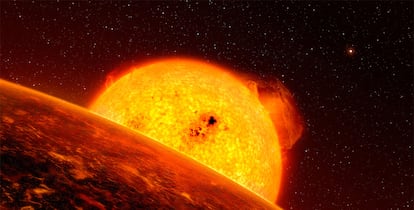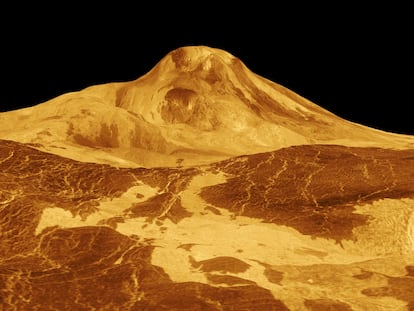Will the Earth burn up someday?
Science enables us to predict the distant future of our planet, which is expected to become a living hell that we can learn a lot from

I have a crystal ball with the fascinating ability to predict the future. It is a precious sphere that has been sculpted by hundreds of thousands of hands over time. It works perfectly, and when it doesn’t, it has the incredible ability to heal itself. It has only one small problem: it’s not easy to learn to use even though it comes with an instruction manual. Still, it’s not one of those devices that you just turn on and start using. Surprisingly, the instruction manual is not dull and consists of books that teach you how to look at, understand and interpret the world. Although it can sometimes be difficult, studying these books will endow you with the ability to write new chapters.
I’m not talking about a tangible object, of course, but a conceptual structure – the laws of physics written down by people over the centuries that help us predict the future of our planet. Using these laws, we can estimate where Mars will be in 2035, 2045 or 3400. We can use our knowledge of the Earth, Sun and all the known planets and moons to launch a spacecraft and place it with astonishing precision on the surface of a moving object millions of miles away by calculating where it will be in several years. This enables us to position cameras on comets, bring back rocks from the Moon, glimpse the far reaches of the Solar System, and create images of objects surrounding black holes. Or simply look into the future of our planet, which is what we are going to do today.
I’ll start with a spoiler – the main character dies in the end. But this story has a fast-paced plot in which supporting characters like us have minor roles. The supporting characters cannot change the end of the story – much of it still unwritten – but they can influence the remaining chapters if only a little.
Let’s travel forward about 50 years and imagine a future where humans have agreed to do something about the atmospheric changes caused by burning fossil fuels. I know it’s difficult because we haven’t done much about it despite knowing what’s coming. But let’s imagine that we manage to halt climate change and save all the insects and biodiversity of our planet. What would happen next? What does the very distant future hold for our world? I’ll be blunt – it will be hell – literally. But as we’ll see, we can learn much from this hell.
In the distant future, our planet will be a living hell from which we can learn a lot
The Sun poses the first significant threat to our planet. We have observed a gradual change in the chemical composition of our star’s core, which has consequences for the Earth. Like all stars, the Sun remains stable for most of its life as it constantly transforms hydrogen into helium in its core. Our star has been doing this for 4.6 billion years, a process that has slowly changed its core density. A change in density implies a higher efficiency of nuclear reactions. As hydrogen is transformed into helium, the core becomes denser because it is compressed, and the core temperature increases, burning hydrogen faster. This increases the Sun’s total energy output. Over the next 1.2 billion years, the Sun’s luminosity (the energy it emits per second) will increase by 10%.
The Earth’s physical properties, geological history and orbit have enabled the conditions for life to exist here. It is estimated that the planet will be able to support life for another 500 million years because current forecasts indicate that, after that time, the Sun’s increasing luminosity will have significant impacts on the biosphere.
So far, the Earth has done an excellent job of maintaining a stable surface temperature. Although we know the massive release of carbon dioxide into the atmosphere will shock the Earth’s climate for the next 100 years, it’s unclear how the Earth will respond to a 10% increase in solar luminosity over the next million years or so.
An increase in radiated energy could evaporate our planet’s atmosphere. But figuring out the future of life on Earth is not so simple. In fact, there is a little-known phenomenon that may have considerable consequences for life in the long term, no matter what the Sun does. And no, I’m not going to talk about meteorites.
Surprise! The Earth’s ability to support life in the future (in thousands of years) may not depend on the Sun but on geodynamic processes on the planet’s surface. Some models estimate that the Earth will be uninhabitable in two billion years when it reaches the ripe old age of 6.5 billion years, regardless of atmospheric evaporation and long before the Sun becomes a red giant. The reason is plate tectonics.
Since its formation, the Earth has been cooling, and its interior has become increasingly viscous. As the viscosity of the Earth’s mantle increases and the outermost part of the lithosphere thickens, plate tectonics slow down. And at some point in the planet’s distant future, in the next billion years, plate tectonics will cease altogether. This must have happened to Mars long ago and perhaps to Venus. Don’t forget that earthquakes are fundamental to the cycles of our planet despite their destructive power.
Carbon dioxide is constantly recycled in and out of the mantle on a planet-sized conveyor belt of rocks. Carbon dioxide dissolves in seawater, reacting with calcium and magnesium salts to form carbonates that are not soluble in water. Without plate tectonics, the recycling of gases will slow down, causing carbon dioxide levels in the atmosphere to fall. While reduced carbon dioxide in the atmosphere means global warming will be slower, it also means that the food chains of all planetary life will collapse because photosynthesis will no longer be possible.
There’s more, but I’ll leave that for another day. In the meantime, with humans ramping up military spending and pumping greenhouse gases into the atmosphere, we may not need to crunch numbers to predict the Earth’s future.
Eva Villaver is a researcher at the Astrobiology Center CAB, a joint center of the Spanish National Research Council (CSIC) and the National Institute of Aerospace Technology (INTA)
Sign up for our weekly newsletter to get more English-language news coverage from EL PAÍS USA Edition
Tu suscripción se está usando en otro dispositivo
¿Quieres añadir otro usuario a tu suscripción?
Si continúas leyendo en este dispositivo, no se podrá leer en el otro.
FlechaTu suscripción se está usando en otro dispositivo y solo puedes acceder a EL PAÍS desde un dispositivo a la vez.
Si quieres compartir tu cuenta, cambia tu suscripción a la modalidad Premium, así podrás añadir otro usuario. Cada uno accederá con su propia cuenta de email, lo que os permitirá personalizar vuestra experiencia en EL PAÍS.
¿Tienes una suscripción de empresa? Accede aquí para contratar más cuentas.
En el caso de no saber quién está usando tu cuenta, te recomendamos cambiar tu contraseña aquí.
Si decides continuar compartiendo tu cuenta, este mensaje se mostrará en tu dispositivo y en el de la otra persona que está usando tu cuenta de forma indefinida, afectando a tu experiencia de lectura. Puedes consultar aquí los términos y condiciones de la suscripción digital.











































